Would you believe if I told you “Goa”, is jam packed with some very ancient, culturally rich and beautiful temples of yore?
I, for one, didn’t. Until, I came back from my maiden trip to this erstwhile party and beach destination where I got an opportunity to explore a few temples of Goa and learn a bit more about it’s fascinating history. The most interesting fact is that Goa, more commonly associated with the Portuguese, was once home to the Konkani tribes which was led by the Maratha Empire. While the Portuguese and the Deccan Sultanate were responsible for demolition of age old temples, the Maratha dynasty directed all their forces in rebuilding all those which are today some of the most wonderful, spectacular and stunning temples in Goa.
Below is a list of 5 most ancient Shiva Temples in Goa that you must not miss while you’re there!
Mangeshi Temple
After having heard so much about Mangeshi temple of Goa which is also one of the largest, wealthiest and the most frequented temple of Goa, I was fortunate to visit this legendary Shiva temple on my first visit to the state. Located 9 kms to the north of Ponda, near the village of Priol, Manguesh temple is the family deity or kuldevta of Gaud Saraswat Brahmins, as also popular to be the family deity of the renowned Mangeshkar family. Visitors can find several hotels in Goa in the Ponda region so you can travel back for a comfortable stay.
 |
| Mangueshi Temple |
Walking on a raised pavement, lined by shacks selling all kinds of religious paraphernalia, past local women selling flowers and bel patra leaf cups, you first reach the temple tank which is said to be the oldest part of the temple. Teeming with a swarm of fishes, the waters are greenish in color and has a stone recording the foundation year of the temple to be as old as 1413. But dig a bit deeper and you realize that the present sacred building housing the Shivlingam was erected much much later, sometime in the eighteenth century.
 |
| Oldest part of the temple |
Once inside, the courtyard is huge and houses the main temple, a nandi bull, a seven storied deepmala and angshalas. The temple as seen today is fairly modern by Indian standards, and does not stand on the original site of where the Shivlingam once was.
When the Portuguese started mass conversions in the Mormugao taluka, the original site of the Manguesh temple, the Gaud Saraswat Brahmins felt a need to move the Mahesh linga from the original site of Kushasthali Cortalim on the Zuari River in order to protect the deity from the invading Portuguese. The linga was then shifted across the river to Priol, where it was secured under the canopy of palm groves for over four centuries before Ramchandra Sukhtankar, a respected general in the Maratha court, facilitated the construction of the (present day) temple around the 18th century.
According to a popular legend, Bhagwan Shiva once lost all his possessions in a game of dice to his wife, Mata Parvati including his heavenly abode atop Mount Kailash. While searching for a new home, he came upon Kushasthali in South Goa where he finally settled for meditation. Mata Parvati, unable to bear the separation for long, came in search of Shiva and confronted a fierce tiger on the way who was none other than Bhagwan himself who had come to test the courage of Mata Parvati.
Terrified, Mata Parvati cried “Trahi Mam Grisha" which meant “Lord of the Mountains, please come and rescue me”. Hearing this Lord Shiva came back into his original form and the two went back to Mount Kailash. However, before leaving Kushasthali, Bhagwan Shiva left a linga which later came to be known as Manguesh, the name derived from “Mam Grisha”.
There are also a few shrines dedicated to the family deities which are located within the temple complex.
Porne Tirth / Koti Tirth Tali
In a small but ancient village of Naroa on the easternmost tip of Divar Island in Goa, lies Porne Tirth or the old pilgrimage of Goa. The quiet village was once home to Saptkoteshwar Mahadev Temple around the 12th century, the Kul Devta of the Kadamba dynasty. However, the temple couldn’t evade the Islamic influence by the Bahamani Sultans in the 14th century. The temple was rebuilt during the Vijaynagar era towards the end of the 14th century but finally succumbed to the invasion by the Portuguese in the 15th century.
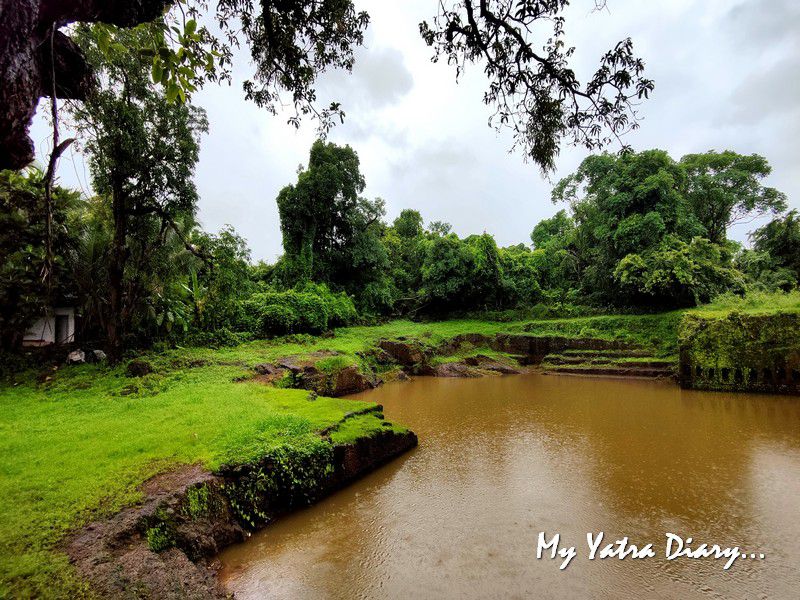 |
| Old Pilgrimage of Goa - Porne Tirth / Koti Tirth Tali |
Though the Shivlinga was taken away to another location, the original temple could never be resurrected again. All that remains today are ruins, a small irregular lake enclosed by laterite walls on one side with steps leading to it.
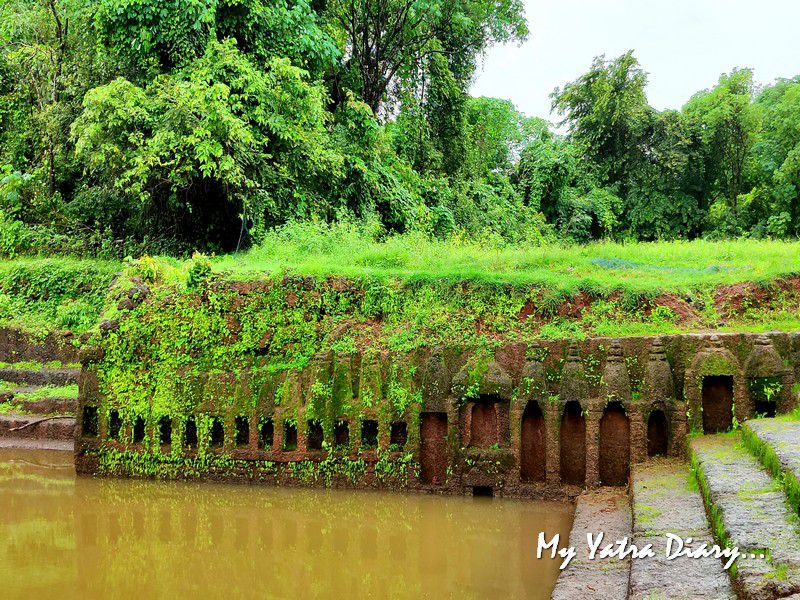 |
| 108 carved niches - Koti Tirth Tali |
What is interesting to see is that the walls have multiple small niches in them which evoke a strong reminder of the past. The water body is surrounded by tall trees and unkempt bushes on all the sides and one can feel a sense of somberness mixed with peace while standing there.
The sacred spot is protected under the supervision of Archaeological survey of India (ASI) and though you won’t find a temple here, but the faith of the people is palpable even in the ruins.
Hatkeshwar Mahadev
Walk a little further from the Porne Tirth and you come across another beautiful gem of a temple, Hatkeshwar Mahadev Temple.
Situated on the extreme edge of the island, the temple is literally a postcard of peace in every sense of the word.
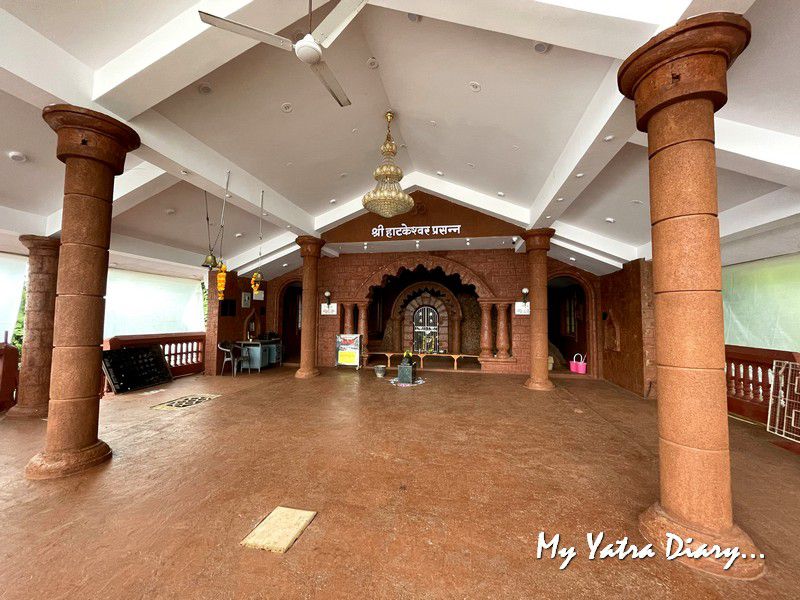 |
| Shree Hatkeshwar Mahadeo, Goa |
There was no one in the temple when we reached and the sky was overcast. Soon, it started raining. The beauty that we saw and experienced was such that we didn't want to leave.
 |
| Overlooking the Mandovi River |
The temple is elevated at a one floor height from the ground and overlooks the peacefully flowing Mandovi River. The garbhagriha or the sanctum sanctorum directly faces the mountains in the distance, and the infinite nature views beyond truly evoke a sense of timelessness, of the divine union of Shiv and Shakti.
Tamdi Surla
The oldest surviving temple of Goa, almost 1000 years old, at the foothills of the Western Ghats, is Tambdi Surla. Located deep inside a dense jungle in the The Bhagwan Mahavir Sanctuary, amidst a blanket of greens, on the Goa Karnataka border, Tambdi Surla is one of the few temples from the Kadamba era that escaped invasion and destruction by the hands of the Muslim and Portuguese invaders.
 |
| Tambdi Surla - Oldest Shiva temple in Goa |
The Kadambas built the temple in fine weather resistant gray basalt rock which was sourced from the Deccan Plateau across the other side of the mountains. The intricate carvings on the outer and inner walls of the temple speak volumes of the skillfulness of the artisans of the time. The structure of the temple is similar to the temples found in Aihole in Karnataka and one can also see some Jain influences in the architecture of the temple which has led to debates about the origins of the temple.
 |
| Shivalingam Tambdi Surla Goa |
Dedicated to Lord Shiva, the temple has a shivling in the garbhagriha (sanctum sanctorum) and a headless Nandi bull in the center of the mandap. According to the local stories, a dimly lit interior of the garbhagriha is home to a huge King Cobra.
 |
| Tambdi Surla waterfall, Goa |
The temple is a sight to behold especially during the monsoon season. It is in the monsoons that the river Surla flowing nearby fills up adding to the charm of the temple. With the gushing sound echoing through the lush greenery and a low mist cover hanging on the ghats, Tambdi Surla attracts a throng of visitors in the rainy season.
The temple, once difficult to get to, is easily accessible by road today. Cars, taxis and buses are easily available to reach the place. The site is located 65 Kms from Panaji (Capital of Goa) and 12 km from the border crossing post of Mollem.
Nagesh Maharudra Temple / Nageshi Temple, Bandora
Another temple in Goa that escaped the hands of Portuguese invasion is the Nageshi Temple in Bandora. However, the present structure of the temple has been renovated multiple times but the deities of Lord Shiva, Parvati and Ganeshji are from the seventh century.
 |
| Nagesh Maharudra Temple Bandora |
This Temple is dedicated to Lord Shiva, the temple is situated in Bandora village, about four kilometers to the east of Ponda.




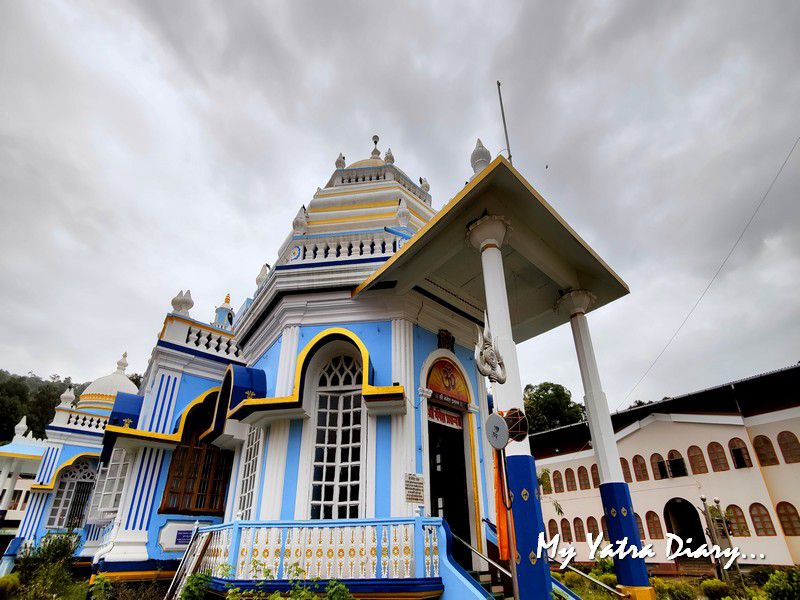
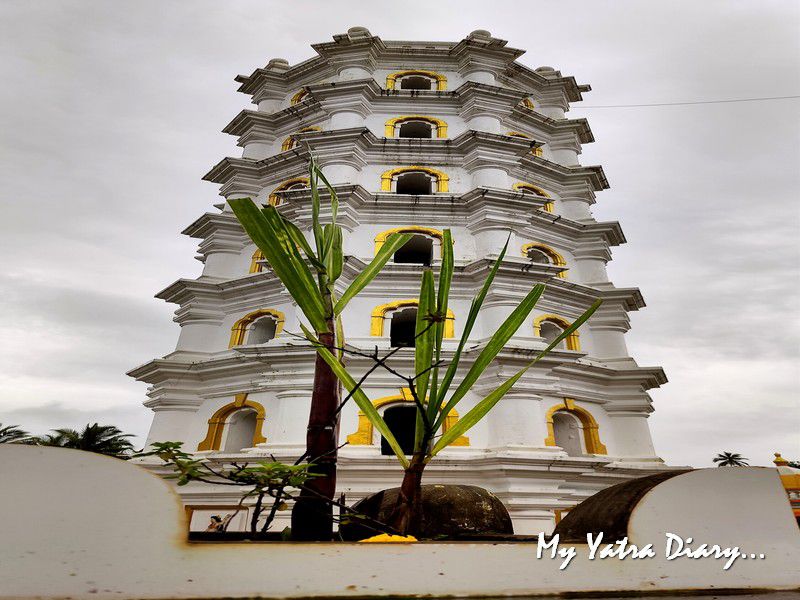

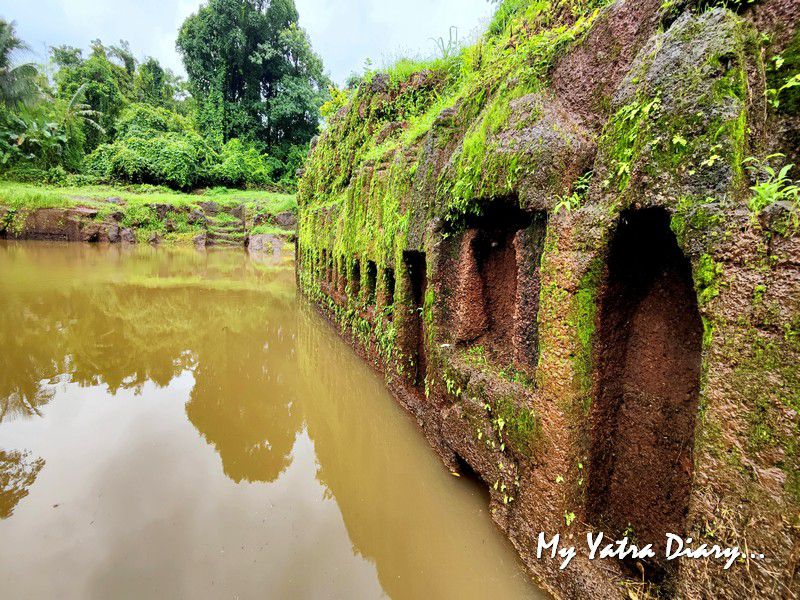

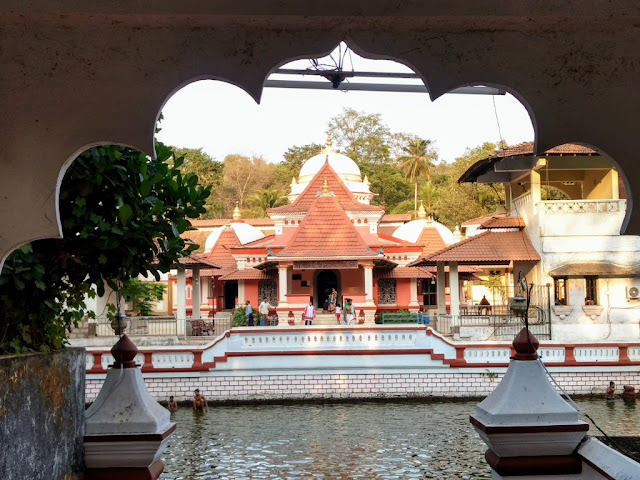

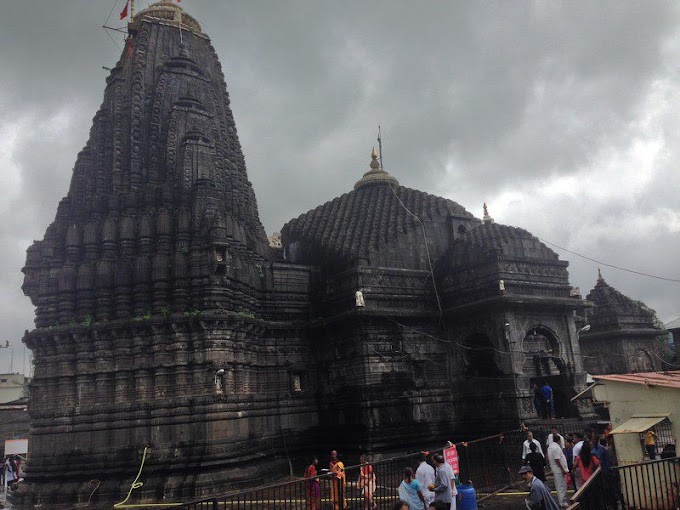



12 Comments
This is such a wonderful and enlightening blog post about the 5 ancient Shiva temples in Goa. You have visited some of the most remarkable and gorgeous temples in India. I enjoyed reading your personal stories and experiences of these temples. Your photos are amazing and capture the essence of these places. You have shared your wisdom and joy!
ReplyDeleteLoving the vibrant blues of the Mangeshi Temple and the legend that saw Bhagwan Shiva once lose all his possessions to his wife in a game of dice, I however love all of the carved niches of the Koti Tirth Tali and the intricate carving on the walls of the Tamdi Surla temple.
ReplyDeleteFor the Seekers of God and Truth...
ReplyDeleteLooking to progress further in your Spiritual Pursuits and Deepen your Yoga, Meditation & Love of God after learning from Living Masters !!!
Visit Krishna.science.blog OR Krishna108.online
It is specifically designed to help in your growth and mental well-being. The content is always free of cost to read and share. For more details, do Visit the site.
Do Share the Love & Knowledge in your physical proximity also!
great places in india to visit . Goa not only for the beaches its also shows our culture
ReplyDeleteWhat a brilliant post and such amazing photos. It was a great article, thanks for sharing!
ReplyDeleteWhatever blogs I’ve read about Goa so far were all about beaches, festivals, and tourist attractions.
ReplyDeleteNever did I get to read about ancient Shiva temples. In fact, I am surprised to read and see all these
ancient temples in Goa. Thanks a lot for your blog.
Thanks for sharing this blog, Keep it up!
ReplyDeleteI love the content on My Yatra Diary! Your travel stories and tips are incredibly inspiring and provide such a vivid picture of the destinations you visit. I especially enjoy the personal touch you bring to each post, making readers feel like they're right there with you. Thank you for sharing your adventures and insights—it's a pleasure to explore the world through your eyes
ReplyDeleteI didn’t realize Goa’s rich history until my first trip there, where I explored its temples. While often linked to Portuguese influence, Goa was originally home to the Konkani tribes under the Maratha Empire. After the Portuguese and the Deccan Sultanate destroyed many ancient temples, the Maratha dynasty rebuilt them, resulting in some of the most stunning temples we see today.
ReplyDeleteThe content from My Yatra Diary is so appealing! Your travel stories and recommendations are so impressive and give off such a clear idea of the places you are going to. What I should emphasize, however, is that the personal touch that you add to each post is especially welcome, as this is the very thing that tells people that they are in the place with you.]] Thank you for sharing your adventures and insights
ReplyDeleteVery beautiful temples. i pray to god to visit them one day .. by ameya jaywant narvekar .. i am myself from goa.
ReplyDelete"Your passion shines through in this post."
ReplyDeleteDelighted you stopped by... Your suggestions, feedback are really appreciated. Thanks a lot :) Hope you visit again!
If you have asked a question, please give me at least 2 days to reply back. Thank you :)